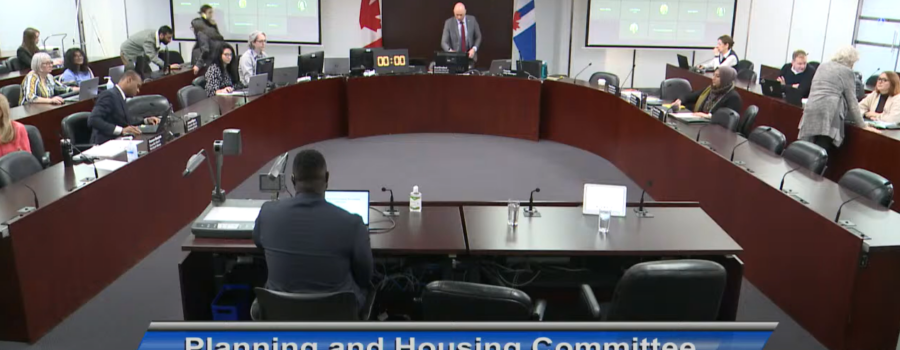On January 19, 2023, I virtually attended a meeting of the City of Toronto’s Planning and Housing Committee. The meeting was just under two hours and in that time, I observed that those in attendance prioritized their own jurisdictions and made decisions based on this. This was clearest in agenda item PH1.7: Accelerating Approvals for Affordable Housing. This can help explain the complicated relationship between governing bodies and how this relationship might impact the effectiveness of addressing housing issues.
I do not have much experience in politics but my overall impression of the meeting environment was that it seemed realistic. Unlike the quickfire political scenes that capture attention in film and television, members regularly asked clarifying questions about the various agenda items before speaking on them. They also raised concerns about the committee’s ability to meet mandates in an acceptable timeframe. There were set times for each aspect of the meeting which the members adhered to, even if it meant that they had to plan additional meetings to continue discussions on a smaller scale. I could tell that they wanted to get through it quickly, which made sense as they seem very busy.
The first items on the agenda were updates and reviews that were received for information. These were followed by items concerning heritage properties, which were adopted at the beginning of the meeting. The rest of the items concerned affordable housing (Planning and Housing Committee, 2023). This included PH1.7, which I chose to further research. This item was presented by Councillor Brad Bradford, who is also the current Chair of the committee. His letter recommends that the committee request that the Chief Planner (and any other relevant divisions) write a report about the feasibility of applying the Community Infrastructure and Housing Accelerator (CIHA) tool to priority affordable housing projects (Bradford, 2023). Through further research I learned that this tool was created by the province in 2022 and can be used to expedite zoning, saving both money and time (Ontario.ca, 2022). It was used in late 2022 by the town of Bowmanville to gain approval for Habitat for Humanity GTA’s 84-unit affordable housing project. Councillor Bradford essentially wants to investigate what the use of this tool would look like in Toronto. Habitat GTA wrote to Councillor Bradford a few days before the meeting in support of his recommendation and requested that he add permanently affordable homeownership units to the list of priority affordable housing projects (Habitat for Humanity GTA, 2023). I recently attended a Habitat for Humanity Niagara presentation discussing their plans to build these units in and around my hometown, so it is interesting to hear about them again in relation to the CIHA tool and Councillor Bradford’s letter.
After Councillor Bradford introduced the letter, he opened the floor to questions. Councillor Malik asked about the specific deliverables of the report and the Chief Planner responded that it would be focused on the CIHA tool (almost exactly repeating Councillor Bradford’s letter). Councillor Malik then asked if the CIHA tool could be used for a specific project in her ward: the Quayside project, led by Waterfront Toronto (Toronto City Council, 2023). I researched this project and learned that it is a development area that will become a mixed-use and mixed-income community that houses over 7000 people. The project page on Waterfront Toronto’s website reads, “More than 800 affordable housing units with more than half the units being family-sized (2+ bedroom). And, affordable housing will be included in each phase of the development, so that these units can be delivered faster” (Waterfront Toronto, 2022). Efficient completion of affordable units is vital to addressing the current housing crisis, which is why Councillor Malik inquired about the use of the CIHA tool. I found the response from staff interesting: according to them, the Quayside project could be considered and the CIHA tool is a formalization of a process that the city had already been doing (Toronto City Council, 2023). The tool means the municipality makes the request instead of the province initiating a Minister’s Zoning Order (MZO). However, requesting the CIHA tool means that the province can add conditions, which it could not do with an MZO.
As the discussion about this item progressed, I detected an edge of bitterness in reference to the provincial government—especially from Councillor Bradford. When discussing previous collaborations with the province, he said, “The city has… worked with the province, that’s how I’m going to describe it” (2023). During that pause, I could see him mentally shuffling through some more distasteful words before choosing a nicer one. This reminded me of our readings and discussions about the policies that different levels of government have created and the ways that they relate to each other, ultimately affecting residents as they are carried out. The HousingTO 2020-2030 Action Plan features a section about intergovernmental partnership that specifically mentions that city residents expect sectors of government to work together to achieve housing results. The plan includes requests to the federal and provincial governments, one of which is that “the provincial government make long-term sustainable investments in affordable and supportive housing, long-term care and support services” (HousingTO, 2019). Councillor Bradford and the committee at large are focused on Toronto and when affordable housing projects are delayed due to provincial policies, it is viewed as a failure to meet the request made in the plan. Similarly, Councillor Malik is focused on her ward which is why she moved to amend the item to include the Quayside project.
This amendment was made and the letter was carried after a vote. Councillor Bradford also updated the letter to include the request from Habitat GTA, which did not require a motion because it did not affect the direction of the letter. The meeting was then adjourned. The fraught discussions that made up the meeting deepened my understanding of the role of municipalities in addressing housing issues. At each level of governance, from ward to city to province, representatives look out for their own jurisdiction first. Conflict can arise when various priorities clash. However, as always, the impact falls on the residents and those who need housing most. While the municipality and province are arguing back and forth about the proper paperwork, the unhoused population of Toronto remains that way. This proves how important it is for government sectors to address these issues together with more coordination than they are currently displaying.





